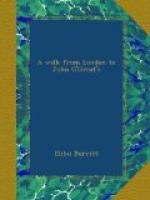Here live the lineal descendants of Thor, christianised to human industries. Here the great hammer of the Scandinavian Thunderer descended, took nest, and hatched a brood of ten thousand little iron beetles for beating iron and steel into shapes and uses that Tubal Cain never dreamed of. Here you may hear their clatter night and day upon a thousand anvils. O, Vale of Vulcan! O, Valley of Knives! Was ever a boy put into trousers, in either hemisphere, that did not carry in the first pocket made for him one of thy cheap blades? Did ever a reaper in the Old World or New cut and bind a sheaf of grain, who did not wield one of thy famous sickles? All Americans who were boys forty years ago, will remember three English centres of peculiar interest to them. These were Sheffield, Colebrook Dale, and Paternoster Row. There was hardly a house or log cabin between the Penobscot and the Mississippi which could not show the imprint of these three places, on the iron tea-kettle, the youngest boy’s Barlow knife, and his younger sister’s picture-book. To the juvenile imagination of those times, Sheffield was a huge jack-knife, Colebrook Dale a porridge-pot, and Paternoster Row a psalm-book, each in the generative case. How we young reapers used to discuss the comparative merits and meanings of those mysterious letters on our sickles, B.Y and I.R! What were they? Were they beginnings of words, or whole words themselves? Did they stand for things, qualities, or persons? “Mine is a By sickle; mine is an Ir one. Mine is the best,” says the last, “for it has the finest teeth and the best curve.” That was our boys’ talk in walking through the rye, with bent backs and red faces, a little behind our fathers; who cut a wider work to enable us to keep near them.
In what blacksmith shop or hardware house in America does not Sheffield show its face and faculties? Did any American, knowing the difference between cast-iron and cast-steel, ever miss the sight of Naylor and Sanderson’s yellow labels in his travels? How many millions of acres of primeval forest have the ages edged with their fine steel cut through, and given to the plough! Fashion has its Iron Age as well as its Golden; and, what is more remarkable, the first of the two has come last, in the fitful histories of custom. And this last freak of feminine taste has brought a wonderful grist of additional business to the Sheffield mill. The fair Eugenie has done a good thing for this smoky town, well deserving of a monument of burnished steel erected to her memory on one of these hills. More than this; as Empress of Crinoline, she should wear the iron crown of Charlemagne in her own right. Her husband’s empire is but a mere arondissement compared with the domain that does homage to her sceptre. Sheffield is the great arsenal of her armaments. Sheffield cases ships of war with iron plates a foot thick; but that is nothing, in pounds avoirdupois, compared with the weight of steel it spins into elastic springs for casing the skirts of two hundred millions of the fair Eugenie’s sex and lieges in the two hemispheres. It is estimated that ten thousand tons of steel are annually absorbed into this use in Christendom; and Sheffield, doubtless, furnishes a large proportion of it.




